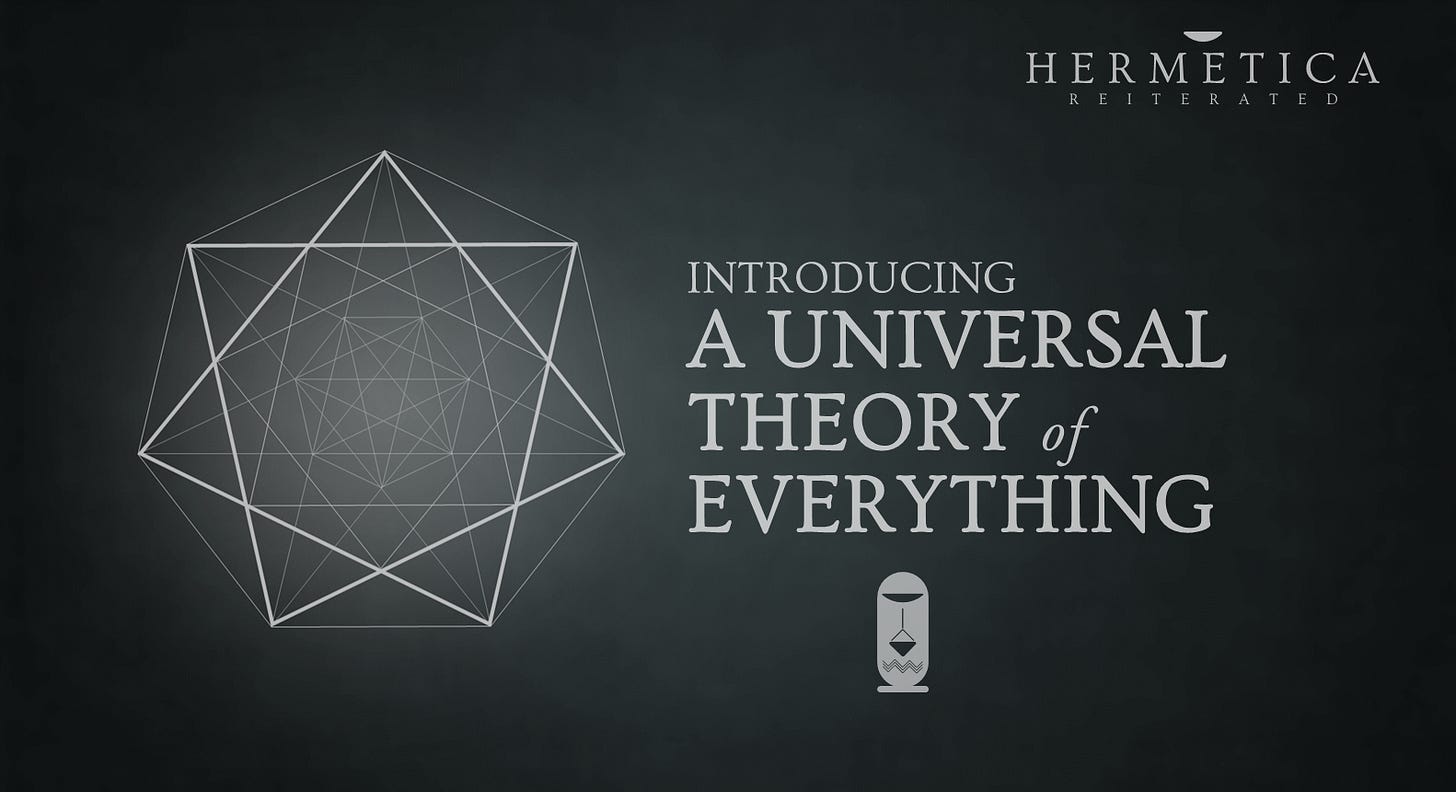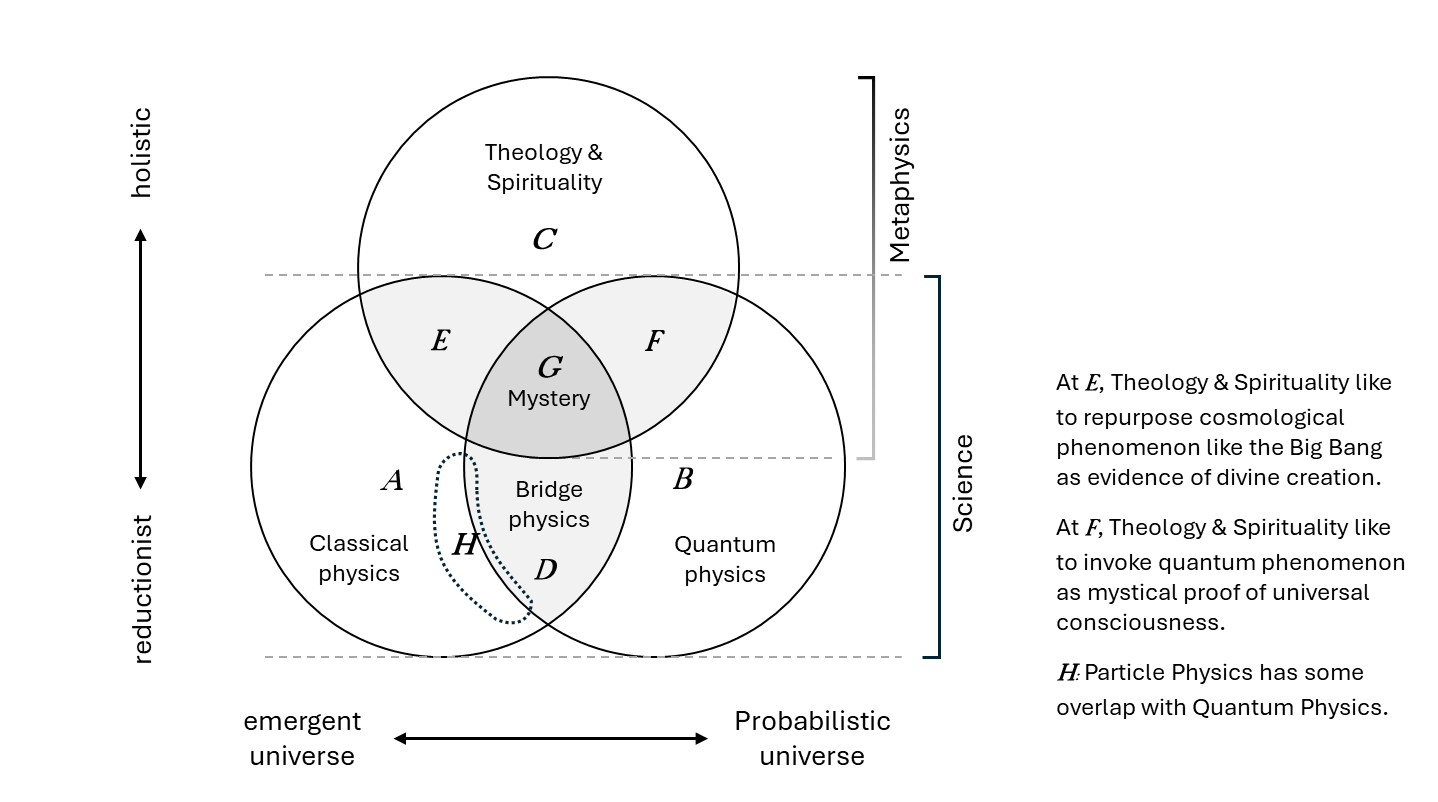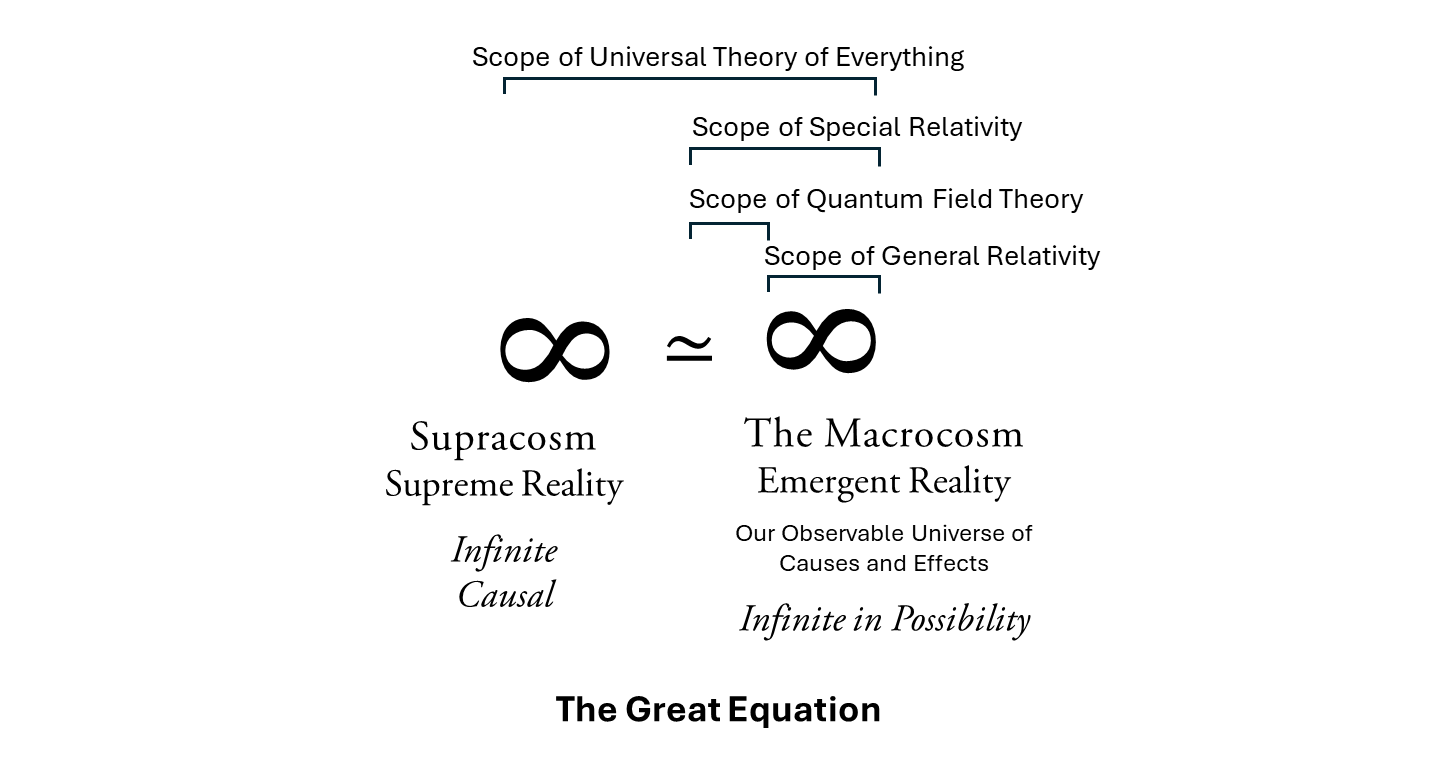Introducing A Universal Theory of Everything
Asserting Hermetics as the The Perennial Philosophy
This is a cross-post from my main substack THOUGHT LEADER. It has been shared because of its profound implications for the project of Reiterating Hermetics.
What if the greatest mysteries of the universe—consciousness, meaning, and the strange gap between quantum physics and everyday reality—could be explained with one simple idea: ‘Reason is Fundamental’. This post takes you on a journey through the hidden logic that might connect science and spirituality without superstition or shortcuts. We will explore why Hermetics, long dismissed as mystical nonsense, may actually hold the key to understanding reality, free will, and even the idea of God—without breaking any known scientific principles. If you have ever wondered whether there is a deeper order behind the chaos, or if a true Theory of Everything is possible, this might just change the way you see it all.
What if we were suddenly given a universal theory of everything—one that not only revealed what reality is and how it works but also showed us, at last, what we might do with such understanding, and especially how we might continue our journey of discovery without causing our future selves deep avoidable regret?
Think about that for a moment.
What if it could answer the deepest questions that have compelled humanity—from the nature of consciousness to the meaning of our lives—not by reducing mystery, but by clarifying its shape and purpose?
What if this universal theory of everything reconciled science and spirituality—not by compromising either, but by expanding both, placing reason and wonder, matter and meaning, in their rightful dialogue?
And what if this theory, far from closing the book on mystery, opened a new chapter—one where understanding and participation, knowledge and wisdom, are no longer divided, but aligned to the same project of exploring life and what we may yet become?
“The definition of apathy is treating something relevant as irrelevant. People are not apathetic because they choose not to care, but because they cannot see why it matters.”
There were two people I was greatly influenced by in my life, and curiously they both came from two opposing intuitions about life and what is real. One was scientifically inclined and the other was an ordained Presbyterian minister. When I first encountered them I was neither a reductionist nor religious, but they left such a powerful lasting mark on my soul and my understanding, as they undoubtedly also did for millions of other people. They came from such different intuitions and yet they both had the gift of communication that was never patronising and always challenged us to be our best selves—they had tact and as close to a universal appeal that humans can possess—absolute paragons of human integrity and thought leadership.
They spoke and acted with grace, were unwaveringly principled and sincere, and for all that, they spoke courageously to authority and were universally adored and respected.
They were of course Carl Sagan and Mister Rogers.
Carl Sagan was the scientist who taught generations how to think and reason with wonder and clarity. He instilled a deep reverence for the rigour of science while showing that this rigour need not strip the universe—or our place within it—of awe and mystery. For Sagan, science was not a cold dissection of reality, but a candle in the dark—a way to navigate both the vast cosmos and the human spirit with humility, curiosity, and a profound sense of belonging to something vastly greater than ourselves.
Mister Rogers, on the other hand, was the humanist who taught generations how to feel and belong, showing that kindness, empathy, and authenticity were not soft virtues, but the strongest foundations for a meaningful life. He met reality on its own terms, never shying away from life’s difficulties, complexities, or tragedies. Though privately devoutly religious, he kept his personal faith from shaping the beliefs of his viewers, choosing instead to teach humanist principles that stood beyond creed or system. His ministry was one of radical acceptance and ethical clarity—rooted not in doctrine, but in the simple, universal truth that every person is worthy of love and respect.
These were the uncles we all wished we had. The one taught us about the Cosmos, and the other one taught us about our Neighborhood. Both taught us about our place within these and how to regard ourselves.
How might they each phrase that same question we began with?
I’ll do my best to channel each in turn, knowing that I might be putting words into their mouth, but all we have sometimes is our imagination. Carl Sagan famously said: “Imagination will often carry us to worlds that never were, but without it we go nowhere.”
So here goes:
Carl Sagan
”What if the cosmos, vast and intricate, operated on a single principle—a Universal Theory of Everything—that not only reconciled science with spirituality but expanded them both, showing that reason and wonder are not opposites but partners? And what if this theory, free of fantasy or superstition, revealed that our longing for meaning is not separate from the universe’s unfolding story, but essential to it?”
Mister Rogers
What if we discovered that the universe is not something 'out there' at all, but something we are already part of—woven into every question, every mystery, every moment of wonder? And what if there were a Universal Theory of Everything that did not put science and spirituality at odds, but showed how each can help us understand the other? What if, instead of chasing answers to feel certain, we learned to sit with the mystery together, knowing that the search for meaning is not just a personal journey, but part of the universe’s way of knowing itself?
Obviously, some poetic license has been applied here, and to keep it real, who could ever fill such enormous shoes as these two exemplars of human wisdom and dignity? Whatever I may have got wrong by imagining what they might have said, I console myself with something Mister Rogers said: “Some days doing ‘the best we can’ may still fall short of what we would like to be able to do—on any front—and doing what we can with what we have is the most we should expect of ourselves or anyone else.”
That said, let’s get to it.
Science vs Mysticism and Science vs Science
The technical side of what I’m about to say might only register with someone already conversant in physics, but the relevance of it should resonate with everyone.
We have three kinds of physics by which we try to describe the universe and explain what we can observe: Classic Physics, Quantum Physics and the Metaphysics of Theology and Spirituality. Let us call these Mystical sciences for the sake of simplicity.
It might sound silly to refer to Mystical anything as a kind of science. We cannot even say it is a soft science exactly either—’soft’ might actually be too generous—psychology and philosophy are ‘soft sciences’, not everything they claim or propose can be proven or tested directly in a lab, but they still adhere to some scientific rigour.
Mystical science does not build its models through reductionist methods like physics does, but instead rests its theories on theological or metaphysical assumptions. Unlike classical or quantum physics, which derive their conclusions from empirical observations and testable hypotheses, Mystical science starts with ontological axioms about the nature of existence, purpose, and consciousness. These axioms often invoke supernatural or unobservable forces, like a divine creator or an underlying consciousness behind reality.
That does not make these pursuits meaningless necessarily—humans have always sought meaning beyond what is measurable—but it does make them fundamentally different in their approach. Where physics moves from the ground up, from particles to planets, theology often moves from the top down, asserting larger truths and then trying to reconcile them with observable reality. This is why we see spiritual traditions eagerly adopt phenomena like the Big Bang or quantum entanglement as proof of their claims: these scientific mysteries leave enough room for metaphysical interpretations.
The strongest case against what we are collectively referring to as ‘mystical science’ is not that it does not have profound meaning for people, but that if we think about how mobile phones work, or satellite navigation, or electricity—these were all products of our reductionist sciences and exceedingly hard—and pointless—to argue with. Sure, we have all seen science practised badly to suit political or corporate interests, but when it comes to creating effective medical equipment, or flying, navigating and landing aeroplanes, the betting man reliably backs the science. Science can prove its claims.
The diagram embedded above illustrates two key things.
There are two contradictions we cannot solve for. The first is the contradiction between mystical 'science' and modern hard science. This is the crux of an age-old debate. Team Mystical claims that science fails to account for some special something responsible for our universe and all the physics and phenomena that science makes its business. Team Science responds by conceding the mystery but asserts that there's no need to assume any special something is responsible. Science says you cannot argue the unprovable and Religion argues you cannot prove the unarguable.
This debate has persisted through centuries, from Galileo's trials against dogma to today's quantum-woo spiritualists who borrow from physics to support metaphysical claims. The tension isn’t about facts alone—it’s about the frameworks we use to make sense of existence. Science demands testable hypotheses and reproducible results, while religion appeals to intuition, tradition, and a sense of the transcendent. Both camps are talking about the same universe, but they’re speaking different languages, and neither side can conclusively resolve the other’s core premise.
Science makes a solid argument, the glaring gap though is how it cannot explain consciousness and it cannot explain the classic stumping questions of:
What caused the Big Bang?
Why does the universe follow mathematical laws?
And why does existence exist at all?
These aren't just abstract riddles; they represent the boundary where scientific explanation runs out of road and metaphysical speculation begins.
These two modes of understanding have often been cast as mutually exclusive—with science dismissing meaning as an artifact of consciousness and spirituality treating matter as secondary to mind.
And then that still leaves us with the second contradiction, which is even more compelling if we are inclined to a reductionist intuition.
On one side, classical physics explains the behaviour of the universe at the scale we can see and measure—objects in motion, forces, energy, and mass—all governed by predictable, deterministic laws. On the other side, quantum physics attempts to explain the behaviour of reality at the smallest scales, where particles blur into waves, probabilities replace certainties, and cause and effect become statistical rather than absolute. Classical physics gives us the orderly, emergent universe we live in; quantum physics reveals the probabilistic, foundational layer beneath it, where reality itself seems more like an ongoing negotiation than a fixed structure. The challenge lies in reconciling these two models because while both are incredibly accurate within their domains, they don’t yet align into a single, unified picture of how the universe really works.
These two models both appear true, yet they cannot be reconciled within the current rubric of the scientific framework they both subscribe to. What works for the vast and the visible breaks down at the scale of the minuscule and the invisible. Science has spent the last century trying to unify these perspectives into a single theory—with limited success. After 100 years, they know a lot more than they did about quantum physics and there have been incredible advances in quantum field theory, cosmology, and our understanding of fundamental particles—but when it comes right down to it, the core mystery remains unsolved: how to bridge the gap between the deterministic laws of the classical world and the probabilistic foundations of the quantum realm.
Notably, the overlap between classical physics and quantum physics we have referred to here as bridge physics implies the inevitable bridge that has to exist between two intractable things that share the same reality at the end of the day. As it stands, that bridge is shaky at best—a patchwork of theories held together by mathematical workarounds rather than a unified, coherent understanding.
Most of us don’t think about this difference because it doesn’t directly affect our day-to-day lives. At best, some folks perhaps consider themselves reductionists or atheists—meaning simply that they trust the observable, measurable universe to explain itself, given enough time and effort. Others lean toward spiritual or philosophical frameworks, sensing that meaning cannot be reduced to mechanics alone.
But this difference—this unresolved split between what is observed and what is experienced—matters more than we might think. It shapes how we relate to the universe, to life, and to each other.
Science appears no closer to explaining its own paradox than it was 100 years ago, but it remains committed to acting as if an answer has to be forthcoming eventually. Science is caught in a very strange knot of its own ideology. The very essence of science is the belief that what got us here will not get us there—this is the definition of critical inquiry and the foundation of the scientific method itself. Yet, ironically, science applies this principle to every external phenomenon except its own underlying assumptions. It continues to rely on the same materialist framework that worked so well for classical physics, even as quantum discoveries repeatedly challenge its adequacy. The belief that the universe must yield to deterministic, reductionist explanations persists, despite mounting evidence that reality at its core may be more emergent, relational, and probabilistic than we ever imagined.
The mystical and the reductionist modes of understanding are typically cast as mutually exclusive—with science dismissing meaning as an artifact of consciousness and spirituality treating matter as secondary to mind.
In a nutshell, the persistent tension between mystical and reductionist models of understanding isn’t a sign of their incompatibility, but of an incomplete framework. The apparent divide between meaning and mechanism, between the emergent and the probabilistic, isn’t a fundamental contradiction—it's a symptom of a deeper, unresolved structure in how we understand reality itself.
A Universal Theory of Everything
A Universal Theory of Everything proposes that not only is it possible to reconcile these three domains into a unified theory, but that doing so requires us to step beyond the assumptions that have kept these perspectives in opposition for so long. The answer lies not in choosing one side over the others, but in recognizing that all three are describing different aspects of the same emergent, self-organizing process that underpins existence.
For a start, the theory states that:
Everything science is trying to solve for is only one side of an equation.
Quantum physics is not the answer—if anything it is the equals sign of that equation.
If the universe is the running program, the equal sign is the compiler that we are looking at in run time. This is like trying to work out how the source code works by staring at the compiler from inside the program that it renders.
A Universal Theory of Everything is a book I am working on that addresses this and so much more.
The thesis of the book is that the answer to the universe’s deepest mysteries—from our side of the equation at least—lies not deeper in quantum physics, or via grand spiritual claims, but in the ancient wisdom of Hermetics: The Perennial Philosophy.
In broad strokes, the book says the following.
Reason is Fundamental. It is the Prime Cause, the underlying principle from which all existence emerges.
Reality is an emulation (not a simulation)—a recursive, emergent expression of Reason interacting with Necessity. What we call the ‘material world’ is simply the run-time state of a deeper, causal architecture governed by immutable principles.
Hermetics, far from the arcane mysticism it has been reduced to, offers a logical, testable framework that resolves the two great contradictions: the divide between science and mysticism, and the irreconcilable gap between classical and quantum physics.
The meaning of life is neither random nor predetermined. It emerges naturally when we grasp that Reason is fundamental—causal, not inferred. From this understanding arises a non-prescriptive but definitive purpose that requires no gods, no magic, and no leaps of faith.
Free Will, long debated as an illusion or theological gift, is revealed as an emergent property of recursive, pattern-sensitive consciousness—an expression of Reason acting through self-aware systems navigating reality's causal architecture.
If there is a God, it is not a bearded overseer or cosmic puppet master. The principle we call ‘God’ is better understood as Reason itself: the causal logic and ‘intentionality’ that underpins existence, impersonal yet profoundly generative.
This hypothesis does not ask you to believe—it invites you to test. It says: Assume Reason is fundamental. From that single assumption, it becomes possible to explain the nature of time, the interplay of Spin, Gravity, and Momentum, the source of emergent order, and the very purpose of consciousness itself.
“You rarely have time for everything you want in this life, so you need to make choices, and hopefully, your choices can come from a deep sense of who you are.” —Mister Rogers
To avoid confusion, I have included two notes about Hermetics and God to help align our understanding and avoid the distortions these words often carry due to their historical and cultural baggage. I want to insulate the value of my work from the myths and assumptions that typically surround them.
Language is only as useful as the shared meaning it conveys, and these terms are easily skewed by preconceived connotations.
Note on ‘Hermetics’
Hermetics has long been dismissed as mystical hokum, yet it holds a rational framework that modern science has overlooked. As we advanced in scientific knowledge, its symbolic, archaic language was never refreshed with discernment. Instead, it was abandoned and later bastardised by the same kinds of spiritual opportunists who co-opted quantum physics without understanding it. If reality is emergent, and Hermetics was originally meant to describe reality, then it is long overdue for a clear, modern reiteration. Principles remain timeless, but their articulation must evolve with the world they describe. One goal of this book is to restore Hermetics as a rational, coherent framework that accurately describes fundamental reality. It was once a finger pointing toward the truth—but we got stuck staring at the finger, the arm, and the robes, forgetting to see what it was pointing toward.
Note on ‘God’
What we call God is not a supernatural being, but the supra-expression of the very qualities we observe as fundamental to reality: understanding, intelligence, reason and consciousness. If reality is an emergent, recursive structure governed by Reason, then God is not an external force acting upon it, but the supreme instance of Reason itself—the causal principle from which all observable phenomena arise. This is not a theological claim, but a logical inference: wherever we see order, pattern, and intelligibility, we see the fingerprints of Reason. God, in this framework, is not a figure to be worshipped, but a principle to be understood—an ultimate coherence that reality mirrors through its emergent complexity.
What’s Next?
All of this, of course, is only the beginning. The questions that have inspired humanity since the dawn of conscious thought—about the nature of existence, consciousness, meaning, and our place in the unfolding universe—are not beyond our grasp. But they will not yield to tired frameworks or familiar assumptions. They require us to think differently, to look with fresh eyes, and to entertain the possibility that Reason, as fundamental and causal, might offer us a bridge across the great divides we have long taken as permanent.
A Universal Theory of Everything is not an end to mystery; it is a reorientation of how we relate to it. It asks us to step beyond the false dichotomies of science and spirituality, mechanism and meaning, certainty and wonder—to hold the paradox with clarity and grace. This work, and this book, is a call to curiosity, to courage, and to intellectual honesty.
In the coming essays and posts, I will continue to unpack these ideas and lay out the framework piece by piece. If you feel the pull of these questions, if you are curious about what it might mean to live in a universe where Reason is Prime, emergence is recursive, and mystery remains intact without superstition—then stay with me.
What comes next might just change how we understand everything.









